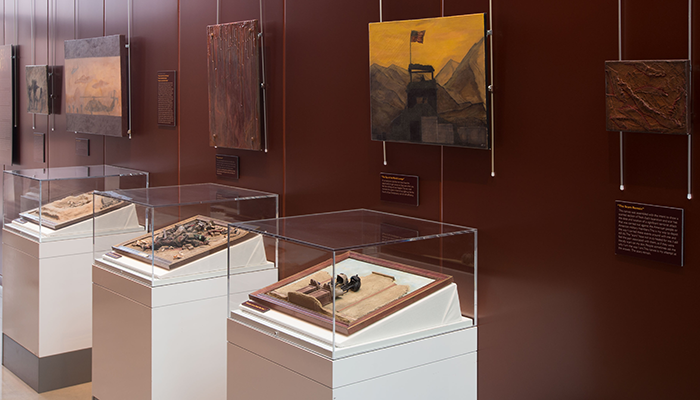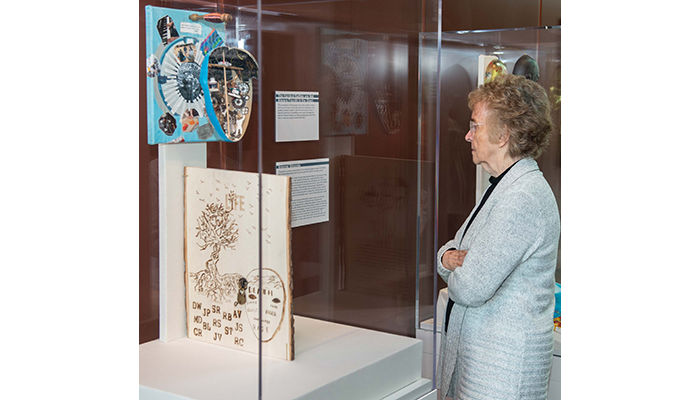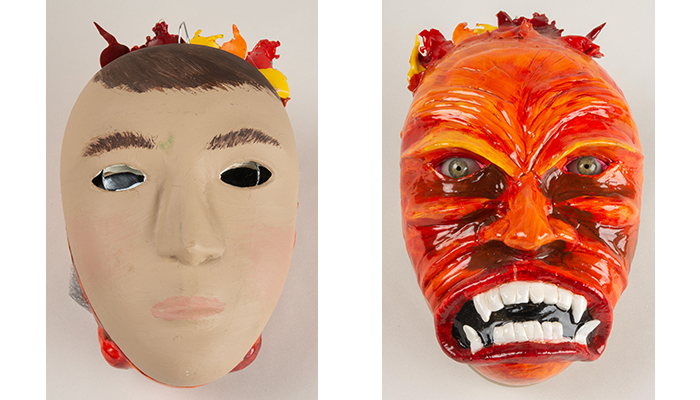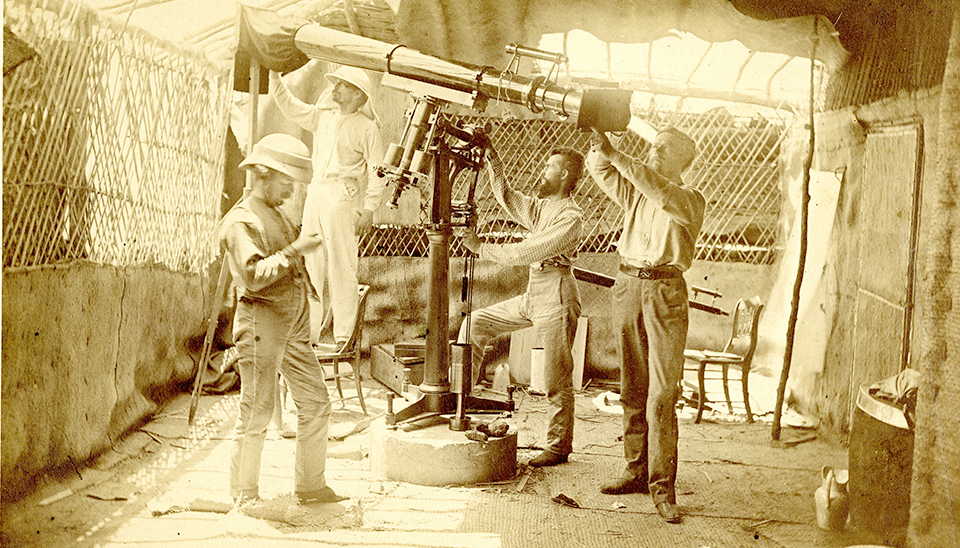Military medical history focuses primarily on how care providers and researchers have contributed to the care and treatment of physical trauma in service members and civilians. In most many cases, there is concrete evidence of a person's injury and/or treatment, such as a broken bone or a diseased organ. However, there is another avenue of trauma that is less tangible.
The National Museum of Health and Medicine (NMHM) collaborated with the National Intrepid Center of Excellence (NICoE) at the Walter Reed National Military Medical Center (WRNMMC) to open a new temporary exhibit on the psychosocial environments of military personnel suffering from traumatic brain injury (TBI) and post-traumatic stress disorder (PTSD). "Visual Voices of the Invisible Wounds of War" will be open from March 8 to May 31 and brings to the museum masks and other artwork produced by service members to show how internal trauma can produce a visual discourse.

National Museum of Health and Medicine (NMHM) Exhibits Manager Steven Hill (center), Assistant Registrar Caitlin Gilroy (right), and Exhibits and Graphics Specialist Laura Thornton (left) prepare a plastic display case for the temporary art therapy exhibit "Visual Voices of the Invisible Wounds of War." (190307-D-MP902-0008: Department of Defense photo by Matthew Breitbart/ Released)
Art therapy is a relatively new addition to the interdisciplinary treatment model for TBI and PTSD patients, and research is being conducted in the Military Health System to better understand how art therapy can assist in the psychological and physical recovery of service members impacted by TBI. Through the exhibit, "Visual Voices of the Invisible Wounds of War," NMHM hopes to inform visitors about the psychological benefits of art therapy for service members who undergo comprehensive treatment plans at the NICoE. Artistic masks, canvas drawings, and other artwork from service members in NICoE's Healing Arts Program are exhibited to represent the visualization of internal conflicts and experiences.

View of "The Scars Remain," a temporary art therapy exhibit that was on display at the National Museum of Health and Medicine from November 2017 through February 2018. (Disclosure: This image has been cropped to emphasize the subject) (180216-D-MP902-0004: National Museum of Health and Medicine photo by Matthew Breitbart/ Released)
This is not the first exhibition where NMHM has presented therapeutic art material. "The Scars Remain," open November 2017 through February 2018 at NMHM, showcased artwork by retired U.S. Army Sgt. Timothy "Mike" Goodrich that he created during treatment at Fort Belvoir Community Hospital. Similarly, "Battle Signs: Using Art Therapy to Process TBI and PTS Injuries and Trauma," open from July through September 2017, exhibited artwork made by four wounded warriors during their art therapy treatment at Fort Belvoir Community Hospital's Intrepid Spirit Center (ISC). Both exhibitions highlighted the positive effects of art therapy as a platform for self-expression and communication.

View of "Battle Signs: Using Art Therapy to Process TBI and PTS Injuries and Trauma," a temporary art exhibit at the National Museum of Health and Medicine displayed from July 2017 through September 2017. (Disclosure: This image has been cropped to emphasize the subject) (170706-D-MP902-004: National Museum of Health and Medicine photo by Matthew Breitbart/ Released)
Comparable to "The Scars Remain" and "Battle Signs: Using Art Therapy to Process TBI and PTS Injuries and Trauma," "Visual Voices of the Invisible Wounds of War" provides museum visitors the opportunity to interact with objects illustrating psychological trauma. Lining the entrance hall of the museum, plexiglass vitrines display various groupings of masks. In vertical plexiglass vitrines, masks that have been decorated on all sides are suspended in the center of the case. These masks communicate the duality of identity many patients feel and the internal struggles developed from external experiences. Museum visitors are encouraged to take their time navigating through the exhibit to absorb the entirety of the visual experience presented by the patients' artwork.

A museum visitor looks at artwork from the temporary art therapy exhibit at the National Museum of Health and Medicine (NMHM) titled "Visual Voices of the Invisible Wounds of War." (190326-D-MP902-0002: Department of Defense photo by Matthew Breitbart/ Released)
In one untitled example, the patient explicitly defines the two sides of his identity. The external, normal painted face is a façade of what people expect him to be, emphasized further by mirrors in the eye cavities, "to reflect the emotion that onlookers want to see." The opposite side of the mask juxtaposes the façade, exposing the patient's internalized identity with an orange mask that conveys anger and rage. The positioning of the object in the vitrine forces the audience to contemplate each side of the mask individually before merging the two in an understanding of a patient's psychosocial experience.

Left: This is one side of the untitled papier-mâché mask decorated with mirrors in the eye cavities. Right: The other side of the papier-mâché mask decorated with prosthetic eyes and acrylic paint. Made by a patient in the Creative Arts Therapy Program at the National Intrepid Center of Excellence (NICoE) at Walter Reed National Military Medical Center (WRNMMC). It is displayed as part of the National Museum of Health and Medicine's (NMHM) March 8 to May 31 art therapy exhibition titled "Visual Voices of the Invisible Wounds of War" in Silver Spring, Maryland. (Disclosure: This image has been cropped to emphasize the subject.) (Department of Defense photo by Matthew Breitbart/ Released)
"Visual Voices of the Invisible Wounds of War" illustrates NMHM's continued interaction with art therapy treatments and the respect for the accomplishments and challenges of service members. Through exhibitions, NMHM shares the experiences with visitors to help them understand the hard road to recovery undertaken by those in our military when they return home.
NMHM has been collecting examples of patient art by service members since World War I. Plans are to continue collecting art therapy objects and related records to better describe the impact and value of military medicine to our nation, so long as the museum's collecting mission is met.
"Visual Voices of the Invisible Wounds of War" is open until May 31 at NMHM.
A directorate of the WRNMMC, in Bethesda, Maryland, the NICoE is dedicated to improving the lives of patients and families affected by traumatic brain injury (TBI) through excellence and innovation, in a collaborative effort with patients, families, referring providers, and researchers. Art therapy treatment and research at the NICoE is possible through Creative Forces: NEA Military Healing Arts Network, a partnership between the National Endowment of the Arts, the Department of Defense, and the Department of Veterans Affairs.
Resources
Relevant Links:
"The Scars Remain," A Wounded Warrior's Art Therapy Exhibit on Display at Military Medical Museum
Wounded Warrior, Art Therapist Shares How Creating Art Helps Heal After Trauma
Wounded Warrior Artists Share Their "Battle Signs" Creations at Medical Museum
Wounded Warriors' Art Therapy Exhibit Opens at DoD Medical Museum




